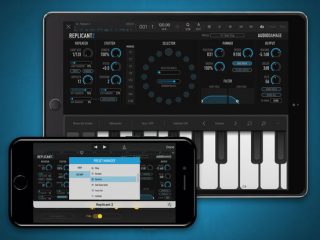Audio Damage has ported its recently updated Replicant 2 buffer effect to iOS.
Replicant is essentially a randomized looper/buffer reverse, with a randomized stutter effect inside the loop. Replicant is capable of simple delay and panning effects, all the way up to “instant Autechre” beat mangling,
The iOS version is essentially the same effect as the desktop version, but at about 1/10th the price.
Features:
- Tempo-based delay and looping effects, from 1/128th note to an entire measure.
- Stutter adds further subdivisions, down to a 1/16384th note (otherwise known as a “tone”.)
- Seven independant randomization controls, for subtle changes or extreme aleatoric madness, including a global randomize button.
- “Hold” feature, to store a random sequence you like.
- Resonant low-pass and high-pass filters that change over time.
- Pan position that changes over time.
- Two separate direction modes, for entire events or individual repeats, with randomization.
- Front panel triggering of loop events for live playing of effects.
Audio Damage notes:
“Replicant 2 is a tempo-based effect, and requires a host that provides transport information. A standalone application is supplied, but it requires an Inter-App Audio connection to a host with a transport to work. We strongly advise using the (identical) AUv3 instead. Ableton Link will be added in the near future for true standalone operation.
Also note that AudioBus 3 does _not_ provide transport information. Hence, Replicant will not work correctly in AudioBus 3. We recommend BeatMaker 3, AUM, Cubasis, ModStep, GarageBand, and similar AUv3 hosts that have a transport.
And finally, we have made an iPhone version available for cross-compatibility, but note that the controls are very small. It can be difficult to use in this context, and we do not recommend it.”
Pricing and Availabiltiy
Replicant 2 is available for iOS for US $4.99. The desktop version is available for $49.


first look no big differences to beat reapeat in ableton!?
You got ableton to run on your iPad? That’s amazing! You need to do a video of that!!
Why are iOS apps so much cheaper than desktop versions?
its the culture of the app store – and to remain competitive you have to stay within the going market value of plugins in that environment
in the culture of VST/AU plugins, its a much higher price point for the overall market
And also VST/AU are not limited to only a single instance.
Neither are AU on iOS. You can run as many instances of an AUv3 (which all Audio Damage apps are) as your iOS device can handle.
It really comes down to the economics of the AppStore; the “going rate” is a lot lower and anything too pricy isn’t purchased.
While this is an immediate boon to iOS musicians, it does raise the question about the long-term viability of the platform.
A lot of established plugin makers have stated no interest in diving into the iOS app world. There are some issues and a not fully-fleshed out spec to contend with (e.g. preset management) that can make porting not as straightforward as a recompile in Xcode. For example, Audio Damage have brought over a bunch of their newer plugins to iOS, but they won’t be porting all of their offerings, as some of the older ones would require a complete rewrite to work on iOS and the economics just don’t justify that kind of labor.
Because mobile is where it’s at daddyo. 😉
No it’s not.
cos the majority of people running plugins or apps on desktop use cracks. But it’s much harder on iOS.
Not judging, just saying….
Hmmmm Didn’t seem to work with Cubasis unless I’m missing something
Yep never mind I had more than a minute with today it’s working on cubasis